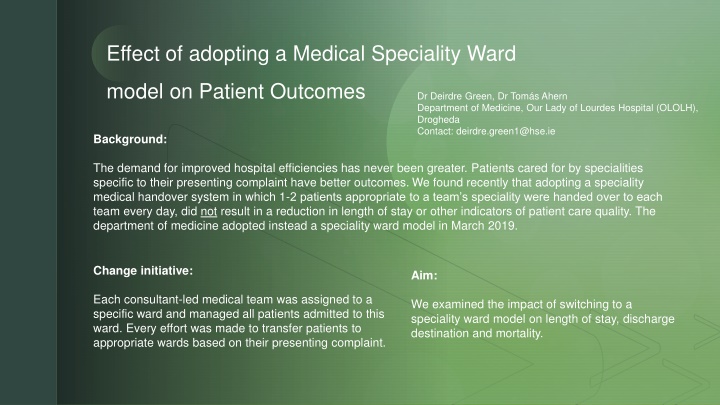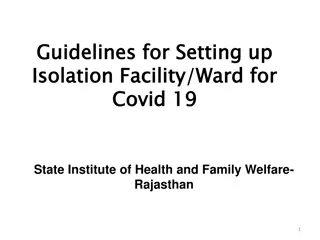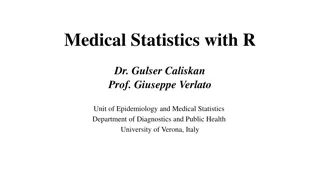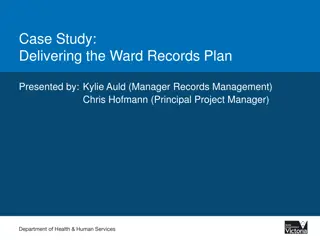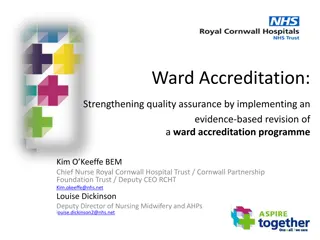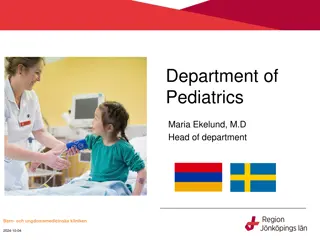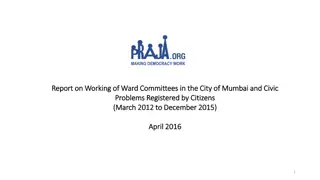Effect of adopting a Medical Speciality Ward
Conducted by Dr. Deirdre Green and Dr. Toms Ahern from the Department of Medicine at Our Lady of Lourdes Hospital (OLOLH) in Drogheda, this study examines the impact of adopting a Medical Specialty Ward model on patient outcomes. The research aims to analyze the effectiveness and implications of this model in enhancing patient care and overall outcomes in a hospital setting.
Download Presentation

Please find below an Image/Link to download the presentation.
The content on the website is provided AS IS for your information and personal use only. It may not be sold, licensed, or shared on other websites without obtaining consent from the author.If you encounter any issues during the download, it is possible that the publisher has removed the file from their server.
You are allowed to download the files provided on this website for personal or commercial use, subject to the condition that they are used lawfully. All files are the property of their respective owners.
The content on the website is provided AS IS for your information and personal use only. It may not be sold, licensed, or shared on other websites without obtaining consent from the author.
E N D
Presentation Transcript
Effect of adopting a Medical Speciality Ward model on Patient Outcomes Dr Deirdre Green, Dr Tom s Ahern Department of Medicine, Our Lady of Lourdes Hospital (OLOLH), Drogheda Contact: deirdre.green1@hse.ie Background: The demand for improved hospital efficiencies has never been greater. Patients cared for by specialities specific to their presenting complaint have better outcomes.We found recently that adopting a speciality medical handover system in which 1-2 patients appropriate to a team s speciality were handed over to each team every day, did not result in a reduction in length of stay or other indicators of patient care quality. The department of medicine adopted instead a speciality ward model in March 2019. Change initiative: Aim: Each consultant-led medical team was assigned to a specific ward and managed all patients admitted to this ward. Every effort was made to transfer patients to appropriate wards based on their presenting complaint. We examined the impact of switching to a speciality ward model on length of stay, discharge destination and mortality.
Results Patient Characteristics Characteristics of patients admitted from the emergency department to the care of a physician in OLOLH during three 5-month time-periods between April 2019 and August 2021 The number of medical in-patients increased by 74% between 2019 and 2021 (3,014 to 5,245) The mean age of patients admitted decreased by 4 years from 2019 (64.5 19.6 years) to 2021 (60.3 20.0 years, p<0.001) The proportion of patients with health insurance increased significantly from 2019 (21.6%) to 2021 (24.1%, p=0.026) as did the proportion of patients who were referred by their primary care physician (27.8% to 38.1%, p<0.001) An ambulance brought 12.5% more medically admitted patients to OLOLH in 2019 (52.1%) than in 2021 (39.6%, p<0.001) The mean National Early Warning Score was higher in 2019 (2.46 2.53) than in 2021 (1.85 +2.13, p<0.001)
Results After introduction of a speciality medical ward model, the length of stay for hospital in-patients admitted under the care of a physician decreased by 30% - the average length of stay in 2019 was 8.8 ( 11.0) days in 2019 and was 6.2 ( 8.9) days in 2021 (p<0.001). This association remained statistically significant after adjustment for potential confounders (p=0.014). Correspondingly, the proportion of patients who were discharged home increased by 12.7% from 2019 (72.5%) to 2021 (85.2%, p<0.001) this association also remained significant after adjusting for confounding variables (p<0.001). The proportion of patients who died in hospital remained low both before introduction of the speciality model (3.58%) and after (2.15%, p<0.001).
Value to patients The introduction of a speciality ward model conferred improvement in inpatient length of stay and inpatient mortality without a requirement for increased resource. The amount of time that patients spent in the emergency prior to admission remained below target despite the increased number of attendances. How was the improvement sustained Data were compared across three time periods; group 1, the pre-intervention group (April to August 2019); group 2, the immediate post-intervention group (April to August 2020); group 3, the late post-intervention group (April to August 2021). Sustained improvement was noted from 2020 to 2021. We plan to implement soon another adjunctive intervention which will hopefully prove beneficial. A Glasgow Admission Prediction Score calculated for each patient in the emergency department will be used to aid bed management in earlier assignment of beds for patients more likely to need admission.
